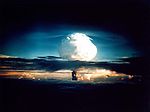High Energy Transient Explorer 1 (HETE-1) was a NASA astronomical satellite with international participation (mainly Japan and France). The concept of...
8 KB (821 words) - 23:47, 31 March 2023
HETE 2 (redirect from High Energy Transient Explorer 2)
High Energy Transient Explorer 2 (HETE-2; also known as Explorer 79) was a NASA astronomical satellite with international participation (mainly Japan and...
18 KB (2,230 words) - 15:21, 17 November 2023
from the original on 2016-03-04. Retrieved 2008-02-27. "The High Energy Transient Explorer (HETE-2)". Massachusetts Institute of Technology. 28 March 2007...
130 KB (5,634 words) - 14:00, 4 November 2024
HETE may refer to: High Energy Transient Explorer Hydroxyeicosatetraenoic acids: 5-Hydroxyeicosatetraenoic acid 8-hydroxyeicosatetraenoic acid (8-HETE)...
543 bytes (92 words) - 20:34, 9 November 2022
resulted in the loss of gamma-burst identifying satellite HETE (High Energy Transient Explorer). The Pegasus XL, introduced in 1994 has lengthened stages to...
50 KB (3,010 words) - 02:52, 11 October 2024
HETE-2: High Energy Transient Explorer (Wiki entry) INTEGRAL: INTErnational Gamma-Ray Astrophysics Laboratory (Wiki entry) BATSE: Burst and Transient Source...
119 KB (12,984 words) - 18:50, 6 November 2024
in Socorro, New Mexico, and the W. M. Keck Observatory; the High Energy Transient Explorer 1 (HETE), launched incorrectly by a Northrop Grumman Pegasus...
272 KB (39,675 words) - 06:52, 21 October 2024
observation of their fading remnants in distant galaxies. The High Energy Transient Explorer 2 (HETE-2) was launched in October 2000 (on a nominally 2-year...
28 KB (3,296 words) - 06:41, 30 June 2024
likely to play a key role in the move to exascale computing. The High Energy Transient Explorer 2 (HETE-2) spacecraft used 4× T805 transputers and 8× DSP56001...
44 KB (5,779 words) - 21:41, 19 October 2024
High Energy Stereoscopic System, a telescope for detecting cosmic rays HET – Hobby–Eberly Telescope HETE – (telescope) High Energy Transient Explorer...
139 KB (13,307 words) - 15:40, 17 September 2024
on 13 August 2002 02:44 UTC by multiple instruments on the High Energy Transient Explorer. The burst lasted approximately 125 seconds. The initial position...
5 KB (521 words) - 18:15, 5 October 2024
produce black holes. Woosley is also co-investigator on the High Energy Transient Explorer-2, a satellite dedicated to the study of gamma-ray bursts, launched...
4 KB (347 words) - 23:25, 26 June 2022
began discussing plans for a new GRB research satellite, the High Energy Transient Explorer (HETE). Although many satellites were already providing data...
30 KB (4,100 words) - 01:35, 24 September 2024
Spectrometer (XGRS) on NEAR Shoemaker, the High Energy Transient Explorer (WMM and SXC), the Rossi X-ray Timing Explorer (PCA and ASM) and Ulysses. "GCN - Missions...
7 KB (779 words) - 05:40, 10 June 2024
NASA HEASARC. Retrieved 2007-12-05. PTInews.com[permanent dead link] HETE-2: High Energy Transient Explorer BATSE: Burst and Transient Source Explorer...
20 KB (2,602 words) - 02:11, 3 November 2024
Physics (MPE) dedicated to time-domain high-energy astrophysics. The primary goals are "to discover high-energy transients and monitor variable objects". The...
9 KB (738 words) - 10:34, 28 October 2024
locate any events with high resolution. Ground-based optical astronomers could look for visual counterparts to the EUV transients seen by ALEXIS by comparing...
6 KB (784 words) - 22:10, 26 September 2023
scientist. In Los Alamos he has worked in: Gamma-ray bursts: High Energy Transient Explorer and HETE-2 satellites, the Raptor telescope suite, the Swift...
11 KB (892 words) - 18:23, 4 June 2024
Climate change (section Clean energy)
global energy change inventory. Warming of the ocean accounts for about 93% of the increase in the Earth's energy inventory between 1971 and 2010 (high confidence)...
310 KB (27,836 words) - 20:54, 8 November 2024
Antarctic Impulse Transient Antenna (ANITA) detects ultra-high-energy cosmic neutrinos believed to be caused by ultra-high-energy cosmic rays The COSMICi...
14 KB (1,484 words) - 15:23, 4 October 2024
2015. "NASA Awards Launch Services Contract for Ionospheric Connection Explorer". NASA. Retrieved 21 November 2014. "NASA Awards Launch Services Contract...
53 KB (2,160 words) - 13:48, 15 October 2024
the low fluxes at higher energies and long enough to detect and monitor a variety of transient sources. Have a median energy below 1 TeV for a Crab-like...
20 KB (2,816 words) - 04:13, 28 October 2024
Future Circular Collider (section High-Energy LHC)
study searches for designs that can withstand the large energy loads with acceptable transient deformation and no permanent damage. Novel composites with...
84 KB (5,757 words) - 21:00, 5 November 2024
detectors designed by Sergei Vernov, followed by the US satellites Explorer 1 and Explorer 3, confirmed the existence of the belt in early 1958, later named...
38 KB (4,436 words) - 00:56, 8 November 2024
Capacitor (category Energy storage)
electrical engineering, a capacitor is a device that stores electrical energy by accumulating electric charges on two closely spaced surfaces that are...
122 KB (15,170 words) - 17:48, 31 October 2024
X-ray astronomy (redirect from High-Energy Focusing Telescope)
space explorer. Except for Explorer 1 and Explorer 3 and the earlier satellites in the series, usually if a probe is going to be a deep space explorer it...
65 KB (8,115 words) - 13:32, 13 April 2024
A fusion energy gain factor, usually expressed with the symbol Q, is the ratio of fusion power produced in a nuclear fusion reactor to the power required...
31 KB (4,207 words) - 01:13, 7 October 2024
Wireless power transfer (redirect from Wireless transmission of energy)
Wireless power transfer (WPT; also wireless energy transmission or WET) is the transmission of electrical energy without wires as a physical link. In a wireless...
119 KB (12,539 words) - 04:46, 14 October 2024
particle physics for studying the origin of high-energy and ultra-high-energy cosmic rays (HECRs and UHECRs) at energies between 1015–1020.5 eV. Both the sites...
33 KB (3,708 words) - 15:04, 5 September 2024
T, ~1013 to 1015 G). The magnetic-field decay powers the emission of high-energy electromagnetic radiation, particularly X-rays and gamma rays. The existence...
31 KB (3,255 words) - 17:35, 5 November 2024




















